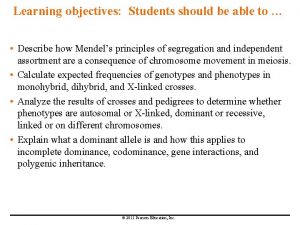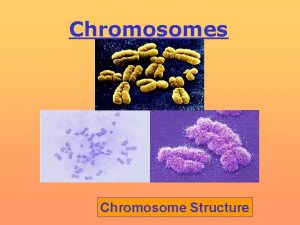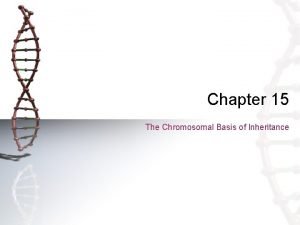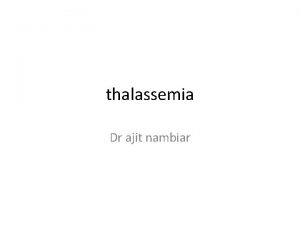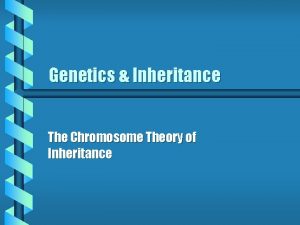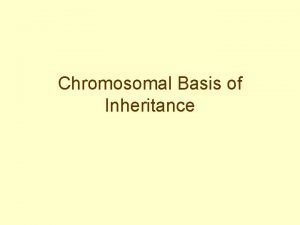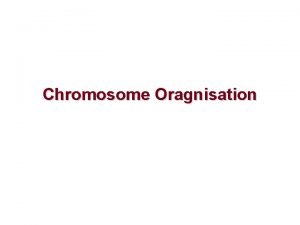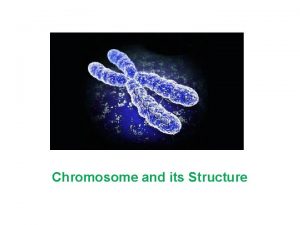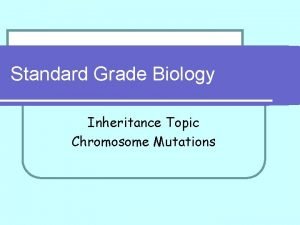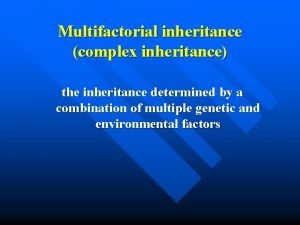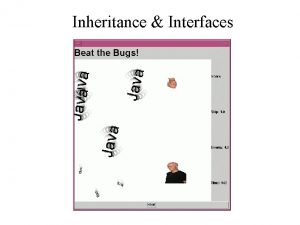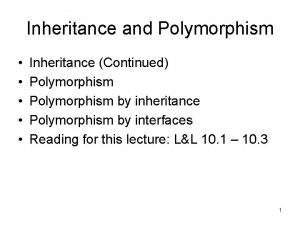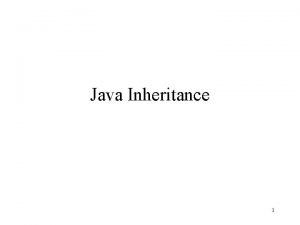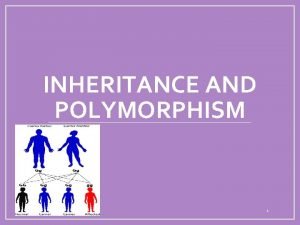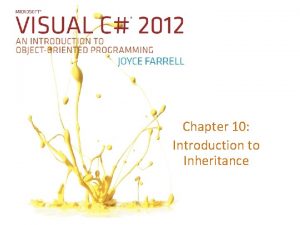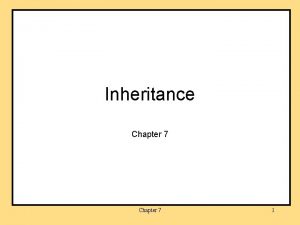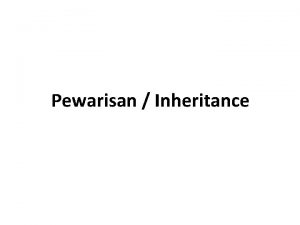The Chromosome Theory of Inheritance Copyright The Mc
























































- Slides: 56

The Chromosome Theory of Inheritance Copyright © The Mc. Graw-Hill Companies, Inc. Permission required to reproduce or display 4 -1

Outline of Chromosome Theory of Inheritance n n n Observations and experiments that placed the hereditary material in the nucleus on the chromosomes Mitosis ensures that every cell in an organism carries same set of chromosomes. Meiosis distributes one member of each chromosome pair to gamete cells. Gametogenesis, the process by which germ cells differentiate into gametes Validation of the chromosome theory of inheritance Copyright © The Mc. Graw-Hill Companies, Inc. Permission required to reproduce or display 4 -2

Evidence that Genes Reside in the Nucleus n 1667 – Anton van Leeuwenhoek Microscopist n Semen contains spermatozoa (sperm animals). n Hypothesized that sperm enter egg to achieve fertilization n n 1854 -1874 – confirmation of fertilization through union of eggs and sperm n Recorded frog and sea urchin fertilization using microscopy and time-lapse drawings and micrographs Copyright © The Mc. Graw-Hill Companies, Inc. Permission required to reproduce or display 4 -3

Evidence that Genes Reside in Chromosomes 1880 s – innovations in microscopy and staining techniques identified thread-like structures n Provided a means to follow movement of chromosomes during cell division n Mitosis – two daughter cells contained same number of chromosomes as parent cell (somatic cells) n Meiosis – daughter cells contained half the number of chromosomes as the parents (sperm and eggs) n Copyright © The Mc. Graw-Hill Companies, Inc. Permission required to reproduce or display 4 -4

One Chromosome Pair Determines an Individual’s Sex. Walter Sutton – Studied great lubber grasshopper n Parent cells contained 22 chromosomes plus an X and a Y chromosome. n Daughter cells contained 11 chromosomes and X or Y in equal numbers. n Copyright © The Mc. Graw-Hill Companies, Inc. Permission required to reproduce or display 4 -5

n After fertilization Cells with XX were females. n Cells with XY were males. n Great lubber grasshopper (Brachystola magna) Fig. 4. 5 Copyright © The Mc. Graw-Hill Companies, Inc. Permission required to reproduce or display 4 -6

n Sex chromosome Provide basis for sex determination n One sex has matching pair. n Other sex has one of each type of chromosome. n Photomicrograph of human X and Y chromosome Fig. 4. 6 a Copyright © The Mc. Graw-Hill Companies, Inc. Permission required to reproduce or display 4 -7

n Sex determination in humans n Fig. 4. 6 b Children receive only an X chromosome from mother but X or Y from father. Copyright © The Mc. Graw-Hill Companies, Inc. Permission required to reproduce or display 4 -8

At Fertilization, Haploid Gametes Produce Diploid Zygotes. n Gamete contains one-half the number of chromosomes as the zygote. Haploid – cells that carry only a single chromosome set n Diploid – cells that carry two matching chromosome sets n n – the number of chromosomes in a haploid cell n 2 n – the number of chromosomes in a diploid cell n Copyright © The Mc. Graw-Hill Companies, Inc. Permission required to reproduce or display 4 -9

diploid vs haploid cell in Drosophila melanogaster Fig. 4. 2 Copyright © The Mc. Graw-Hill Companies, Inc. Permission required to reproduce or display 4 -10

The number and shape of chromosomes vary from species to species. n 2 n Organism n 2 n Drosophila melanogaster Drosophila obscura 4 5 8 10 Drosophila virilus Peas Macaroni wheat Giant sequoia trees Goldfish Dogs Humans 6 7 14 11 47 39 23 12 14 28 22 94 78 46 Copyright © The Mc. Graw-Hill Companies, Inc. Permission required to reproduce or display 4 -11

Anatomy of a chromosome Metaphase chromosomes are classified by the position of the centromere Fig. 4. 3 Copyright © The Mc. Graw-Hill Companies, Inc. Permission required to reproduce or display 4 -12

Homologous chromosomes match in size, shape, and banding patterns. Homologous chromosomes (homologs) contain the same set of genes. n Genes may carry different alleles. n Nonhomologous chromosomes carry completely unrelated sets of genes. n Copyright © The Mc. Graw-Hill Companies, Inc. Permission required to reproduce or display 4 -13

Karyotypes can be produced by cutting micrograph images of stained chromosomes and arranging them in matched pairs Human male karyotype Fig 4. 4 Copyright © The Mc. Graw-Hill Companies, Inc. Permission required to reproduce or display 4 -14

Autosomes – pairs of nonsex chromosomes Sex chromosomes and autosomes are arranged in homologous pairs Note 22 pairs of autosomes and 1 pair of sex chromosomes Copyright © The Mc. Graw-Hill Companies, Inc. Permission required to reproduce or display 4 -15

There is variation between species in how chromosomes determine an individual’s sex. _________________________ Chromosome Females Males Organism _________________________ XX-XY XX XY Mammals, Drosophila XX-XO XX XO Grasshoppers ZZ-ZW ZW ZZ Fish, Birds, Moths _________________________ Table 4. 1 Copyright © The Mc. Graw-Hill Companies, Inc. Permission required to reproduce or display 4 -16

Complement of sex chromosomes Humans – presence of Y determines sex Drosophila – ratio of autosomes to X chromosomes determines sex Drosophila Humans XXX XX XXY XO XY XYY OY Dies Normal female Sterile male Normal male Dies Klinefelter male (sterile); tall, thin Turner female (sterile); webbed neck Nearly Normal normal female ♀ Normal or Dies male nearly normal male Copyright © The Mc. Graw-Hill Companies, Inc. Permission required to reproduce or display 4 -17

Mitosis ensures that every cell in an organism carries the same chromosomes. n Cell cycle – repeating pattern of cell growth and division n n Alternates between interphase and mitosis Interphase – period of cell cycle between divisions/cells grow and replicate chromosomes G 1 – gap phase – birth of cell to onset of chromosome replication/cell growth n S – synthesis phase – duplication of DNA n G 2 – gap phase – end of chromosome replication to onset of mitosis Copyright © The Mc. Graw-Hill Companies, Inc. Permission required to reproduce or display n 4 -18

The cell cycle Fig. 4. 7 a Copyright © The Mc. Graw-Hill Companies, Inc. Permission required to reproduce or display 4 -19

Chromosome replication during S phase of cell cycle Synthesis of chromosomes Note the formation of sister chromatids Fig. 4. 7 b Copyright © The Mc. Graw-Hill Companies, Inc. Permission required to reproduce or display 4 -20

Interphase n Within nucleus n n G 1, S, and G 2 phase – cell growth, protein synthesis, chromosome replication Outside of nucleus n Formation of microtubules radiating out into cytoplasm crucial for interphase processes n Centrosome – organizing center for microtubules located near nuclear envelope n Centrioles – pair of small darkly stained bodies at center of centrosome in animals (not found in plants) Copyright © The Mc. Graw-Hill Companies, Inc. Permission required to reproduce or display 4 -21

Mitosis – Sister chromatids separate n Prophase – chromosomes condense n Inside nucleus n n n Fig. 4. 8 a Chromosomes condense into structures suitable for replication. Nucleoli begin to break down and disappear. Outside nucleus n n Centrosomes which replicated during interphase move apart and migrate to opposite ends of the nucleus. Interphase microtubules disappear and are replaced by microtubules that rapidly grow from and contract back to centrosomal organizing centers. Copyright © The Mc. Graw-Hill Companies, Inc. Permission required to reproduce or display 4 -22

Mitosis - continued n Prometaphase n n Fig. 4. 8 b Nuclear envelope breaks down Microtubules invade nucleus Chromosomes attach to microtubules through kinetochore Mitotic spindle – composed of three types of microtubules n n n Kinetochore microtubules – centrosome to kinetochore Polar microtubules – centrosome to middle of cell Astral microtubules – centrosome to cell’s periphery Copyright © The Mc. Graw-Hill Companies, Inc. Permission required to reproduce or display 4 -23

Mitosis - continued n Metaphase – middle stage n Chromosomes move towards imaginary equator called metaphase plate Fig. 4. 8 c Copyright © The Mc. Graw-Hill Companies, Inc. Permission required to reproduce or display 4 -24

Mitosis - continued n Anaphase n Separation of sister chromatids allows each chromatid to be pulled towards spindle pole connected to by kinetochore microtubule. Copyright © The Mc. Graw-Hill Companies, Inc. Permission required to reproduce Fig. 4. 8 d or display 4 -25

Mitosis – continued n Telophase n n n Fig. 4. 8 e Spindle fibers disperse Nuclear envelope forms around group of chromosomes at each pole One or more nucleoli reappear Chromosomes decondense Mitosis complete Copyright © The Mc. Graw-Hill Companies, Inc. Permission required to reproduce or display 4 -26

Mitosis - continued n Cytokinesis - cytoplasm divides n n n Fig. 4. 8 f Starts during anaphase and ends in telophase Animal cells – contractile ring pinches cells into two halves Plant cells – cell plate forms dividing cell into two halves Copyright © The Mc. Graw-Hill Companies, Inc. Permission required to reproduce or display 4 -27

Checkpoint s help regulate cell cycle Fig. 4. 11 Copyright © The Mc. Graw-Hill Companies, Inc. Permission required to reproduce or display 4 -28

Meiosis produces haploid germ cells. Somatic cells – divide mitotically and make up vast majority of organism’s tissues n Germ cells – specialized role in the production of gametes n Arise during embryonic development in animals and floral development in plants n Undergo meiosis to produce haploid gametes n Gametes unite with gamete from opposite sex to produce diploid offspring. n Copyright © The Mc. Graw-Hill Companies, Inc. Permission required to reproduce or display 4 -29

Meiosis Chromosomes replicate once. Nuclei divide twice. Fig. 4. 12 Copyright © The Mc. Graw-Hill Companies, Inc. Permission required to reproduce or display 4 -30

Meiosis – Prophase I Feature Figure 4. 13 Copyright © The Mc. Graw-Hill Companies, Inc. Permission required to reproduce or display 4 -31

Meiosis – Prophase I continued Copyright © The Mc. Graw-Hill Companies, Inc. Permission required to reproduce or display 4 -32

Crossing over during prophase produces recombined chromosomes. Fig. 4. 14 a-c Copyright © The Mc. Graw-Hill Companies, Inc. Permission required to reproduce or display 4 -33

Fig. 4. 14 d, e Copyright © The Mc. Graw-Hill Companies, Inc. Permission required to reproduce or display 4 -34

How crossing over produces recombined gametes Fig. 4. 15 Copyright © The Mc. Graw-Hill Companies, Inc. Permission required to reproduce or display 4 -35

Meiosis I – Metaphase and Anaphase Copyright © The Mc. Graw-Hill Companies, Inc. Permission required to reproduce or display 4 -36

Meiosis – Telophase I and Interkinesis Copyright © The Mc. Graw-Hill Companies, Inc. Permission required to reproduce or display 4 -37

Meiosis – Prophase II and Metaphase II Copyright © The Mc. Graw-Hill Companies, Inc. Permission required to reproduce or display 4 -38

Meiosis – Anaphase II and Telophase II Copyright © The Mc. Graw-Hill Companies, Inc. Permission required to reproduce or display 4 -39

Meiosis - Cytokenesis Fig. 4. 13 Copyright © The Mc. Graw-Hill Companies, Inc. Permission required to reproduce or display 4 -40

Meiosis contributes to genetic diversity in two ways. Independent assortment of nonhomologous chromosomes creates different combinations of alleles among chromosomes. n Crossing-over between homologous chromosomes creates different combinations of alleles within each chromosome. n Copyright © The Mc. Graw-Hill Companies, Inc. Permission required to reproduce or display 4 -41

Fig. 4. 17 Copyright © The Mc. Graw-Hill Companies, Inc. Permission required to reproduce or display 4 -42

Gametogenesis involved mitosis and meiosis. n Oogenesis – egg formation in humans Diploid germ cells called oogonia multiply by mitosis to produce primary oocytes. n Primary oocytes undergo meiosis I to produce one secondary oocyte and one small polar body (which arrests development). n Secondary oocyte undergoes meiosis II to produce one ovum and one small polar body. n Polar bodies disintegrate leaving one large functional gamete n Copyright © The Mc. Graw-Hill Companies, Inc. Permission required to reproduce or display 4 -43

Oogenesis in humans Fig 4. 18 Copyright © The Mc. Graw-Hill Companies, Inc. Permission required to reproduce or display 4 -44

Gametogenesis n Spermatogenesis in humans Symmetrical meiotic divisions produce four functional sperm. n Begins in male testis in germ cells called spermatogonia n Mitosis produces diploid primary spermatocytes. n Meiosis I produces two secondary spermatocytes per cell. n Meiosis II produces four equivalent spermatids. n Spematids mature into functional sperm. n Copyright © The Mc. Graw-Hill Companies, Inc. Permission required to reproduce or display 4 -45

Spermatogenesis in humans Fig. 4. 19 Copyright © The Mc. Graw-Hill Companies, Inc. Permission required to reproduce or display 4 -46

The chromosome theory correlates Mendel’s laws with chromosome behavior during meiosis. n n n Chromosome Behavior Each cell contains two copies of each chromosome Chromosome complements appear unchanged during transmission from parent to offspring. Homologous chromosomes pair and then separate to different gametes. Maternal and paternal copies of chromosome pairs separate without regard to the assortment of other homologous chromosome pairs. At fertilization an egg’s set of chromosomes unite with randomly encountered sperm’s chromosomes. In all cells derived from a fertilized egg, one half of chromosomes are of maternal origin, and half are paternal. n n n Behavior of genes Each cell contains two copies of each gene. Genes appear unchanged during transmission from parent to offspring. Alternative alleles segregate to different gametes. Alternative alleles of unrelated genes assort independently. Alleles obtained from one parent unite at random with those from another parent. In all cells derived from a fertilized gamete, one half of genes are of maternal origin, and half are paternal. Copyright © The Mc. Graw-Hill Companies, Inc. Permission required to reproduce or display 4 -47

Specific traits are transmitted with specific chromosomes. n A test of the chromosome theory If genes are on specific chromosomes, then traits determined by the gene should be transmitted with the chromosome. n T. H. Morgan’s experiments demonstrating sex -linked inheritance of a gene determining eyecolor demonstrate the transmission of traits with chromosomes. n 1910 – T. H. Morgan discovered a white – eyed male, Drosophila melanogaster, among his stocks. n Copyright © The Mc. Graw-Hill Companies, Inc. Permission required to reproduce or display 4 -48

Nomenclature for Drosophila genetics n Wild-type allele - allele that is found in high frequency in a population n n Mutant allele - allele found in low frequency n n n Denoted with a “+” Denoted with no symbol Recessive mutation - gene symbol is in lower case Dominant mutation - gene symbol is in upper case Copyright © The Mc. Graw-Hill Companies, Inc. Permission required to reproduce or display 4 -49

Examples of notations for Drosophila n Gene symbol is chosen arbitrarily n e. g. , Cy is curly winged, v is vermilion eyed, etc. Cy, Sb, D are dominant (upper case letter). n vg, y, e, are recessive (lower case letter). n vg+ - wild-type recessive allele for vestigial gene locus n Cy+ - wild-type dominant allele for curly n Copyright © The Mc. Graw-Hill Companies, Inc. Permission required to reproduce or display 4 -50

Criss-cross inheritance of the white gene demonstrates X-linkage. Fig. 4. 20 Copyright © The Mc. Graw-Hill Companies, Inc. Permission required to reproduce or display 4 -51

Rare events of nondisjunction in XX female produce XX and O eggs. Segregation in an XX female Fig. 4. 21 a Copyright © The Mc. Graw-Hill Companies, Inc. Permission required to reproduce or display 4 -52

Segregation in an XXY female Fig. 4. 21 b Copyright © The Mc. Graw-Hill Companies, Inc. Permission required to reproduce or display 4 -53

n X and Y linked traits in humans are identified by pedigree analysis. X-linked traits exhibit five characteristics seen in pedigrees. Trait appears in more males than females. n Mutation and trait never pass from father to son. n Affected male does pass X-linked mutation to all daughters, who are heterozygous carriers. n Trait often skips a generation. n Trait only appears in successive generations if sister of an affected male is a carrier. If so, one half of her sons will show trait. n Copyright © The Mc. Graw-Hill Companies, Inc. Permission required to reproduce or display 4 -54

Example of sex-linked recessive trait in human pedigree – hemophilia Fig. 4. 23 a Copyright © The Mc. Graw-Hill Companies, Inc. Permission required to reproduce or display 4 -55

Example of sex-linked dominant trait in human pedigree – hypophosphatemia Fig. 4. 23 b Copyright © The Mc. Graw-Hill Companies, Inc. Permission required to reproduce or display 4 -56
 Chromosome theory of inheritance
Chromosome theory of inheritance How to read chromosome
How to read chromosome Chapter 15 the chromosomal basis of inheritance
Chapter 15 the chromosomal basis of inheritance Mendel's three laws
Mendel's three laws Mendelian genetics
Mendelian genetics Hình ảnh bộ gõ cơ thể búng tay
Hình ảnh bộ gõ cơ thể búng tay Lp html
Lp html Bổ thể
Bổ thể Tỉ lệ cơ thể trẻ em
Tỉ lệ cơ thể trẻ em Chó sói
Chó sói Tư thế worm breton
Tư thế worm breton Chúa yêu trần thế
Chúa yêu trần thế Môn thể thao bắt đầu bằng chữ f
Môn thể thao bắt đầu bằng chữ f Thế nào là hệ số cao nhất
Thế nào là hệ số cao nhất Các châu lục và đại dương trên thế giới
Các châu lục và đại dương trên thế giới Công thức tính độ biến thiên đông lượng
Công thức tính độ biến thiên đông lượng Trời xanh đây là của chúng ta thể thơ
Trời xanh đây là của chúng ta thể thơ Mật thư tọa độ 5x5
Mật thư tọa độ 5x5 Phép trừ bù
Phép trừ bù Phản ứng thế ankan
Phản ứng thế ankan Các châu lục và đại dương trên thế giới
Các châu lục và đại dương trên thế giới Thể thơ truyền thống
Thể thơ truyền thống Quá trình desamine hóa có thể tạo ra
Quá trình desamine hóa có thể tạo ra Một số thể thơ truyền thống
Một số thể thơ truyền thống Cái miệng nó xinh thế
Cái miệng nó xinh thế Vẽ hình chiếu vuông góc của vật thể sau
Vẽ hình chiếu vuông góc của vật thể sau Biện pháp chống mỏi cơ
Biện pháp chống mỏi cơ đặc điểm cơ thể của người tối cổ
đặc điểm cơ thể của người tối cổ Giọng cùng tên là
Giọng cùng tên là Vẽ hình chiếu đứng bằng cạnh của vật thể
Vẽ hình chiếu đứng bằng cạnh của vật thể Vẽ hình chiếu vuông góc của vật thể sau
Vẽ hình chiếu vuông góc của vật thể sau Thẻ vin
Thẻ vin đại từ thay thế
đại từ thay thế điện thế nghỉ
điện thế nghỉ Tư thế ngồi viết
Tư thế ngồi viết Diễn thế sinh thái là
Diễn thế sinh thái là Dot
Dot Bảng số nguyên tố lớn hơn 1000
Bảng số nguyên tố lớn hơn 1000 Tư thế ngồi viết
Tư thế ngồi viết Lời thề hippocrates
Lời thề hippocrates Thiếu nhi thế giới liên hoan
Thiếu nhi thế giới liên hoan ưu thế lai là gì
ưu thế lai là gì Hổ đẻ mỗi lứa mấy con
Hổ đẻ mỗi lứa mấy con Sự nuôi và dạy con của hổ
Sự nuôi và dạy con của hổ Sơ đồ cơ thể người
Sơ đồ cơ thể người Từ ngữ thể hiện lòng nhân hậu
Từ ngữ thể hiện lòng nhân hậu Thế nào là mạng điện lắp đặt kiểu nổi
Thế nào là mạng điện lắp đặt kiểu nổi Prisma inheritance
Prisma inheritance Object diagram java
Object diagram java Priority inheritance
Priority inheritance Donna malayeri
Donna malayeri The inheritance of loss summary
The inheritance of loss summary Thalassemia trait
Thalassemia trait Rails sti vs polymorphic
Rails sti vs polymorphic Sex linked punnett square example
Sex linked punnett square example Sexlinked inheritance
Sexlinked inheritance Quantitative traits
Quantitative traits
